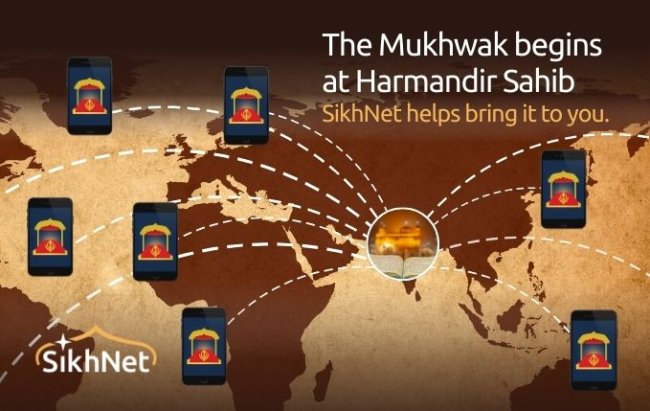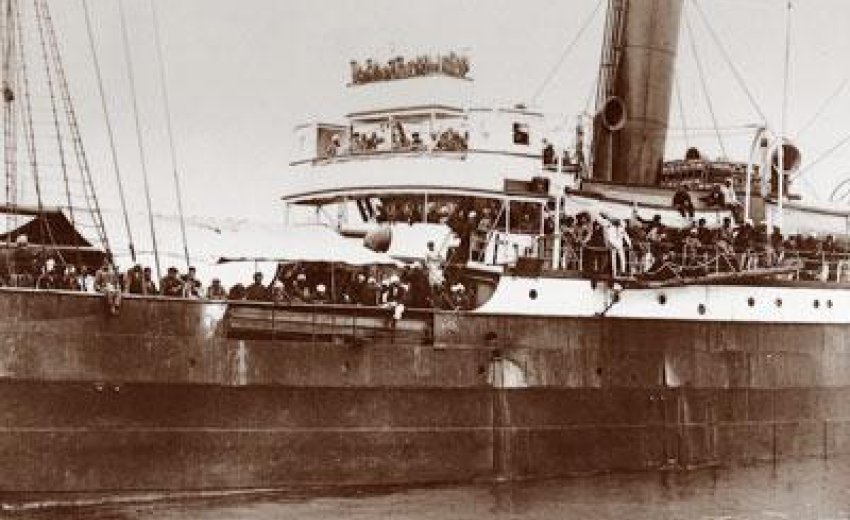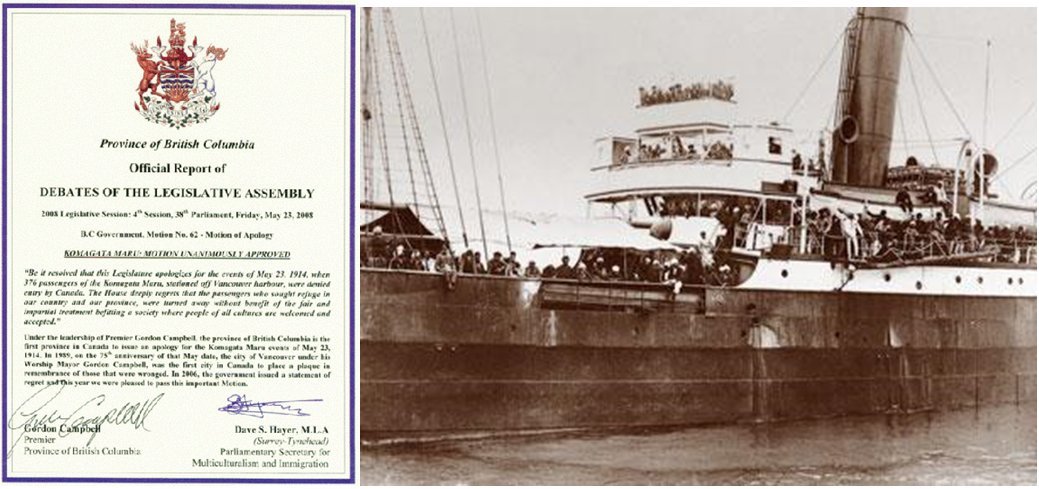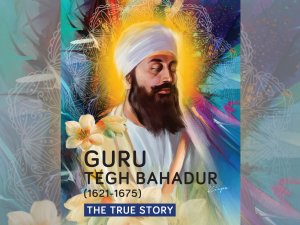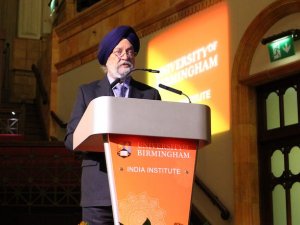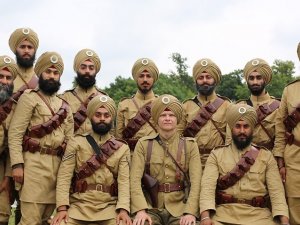| ||
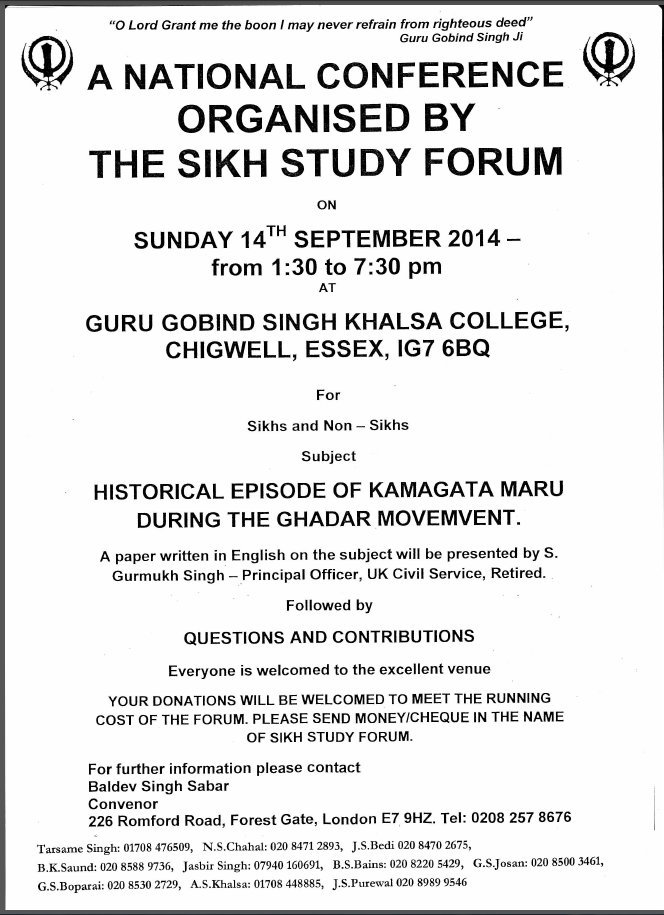 |
The paper on the Komagata Maru incident to be presented by Gurmukh Singh
| Historical Episode of Komagata Maru during the Ghadar Movement (by Gurmukh Singh) _________________________________ |
|
Part I Historical and Ideological context of the Komagata Maru incident during the Ghadar Movement "This ship belongs to the whole of India, this is a symbol of the honour of India and if this was detained, there would be mutiny in the armies." When invited to write this paper about the Komagata Maru episode during the Ghadar Movement, I started with some facts and figures. I also had in mind the words of a renowned patriot, Baba Sohan Singh Bhakna, the first President of the Ghadar Party. He said: "We were not Sikhs or Punjabis. Our religion was patriotism." The ship, Komagata Maru carried 376 passengers consisting of 340 Sikhs, 24 Muslims, and 12 Hindus, all British subjects. When looking at these figures, not only do we need to bear in mind the population mix of undivided Punjab before 1947, but also take into account the fact that the total Sikh population in 1914, when the ship set sail for Canada, was no more than about 3 million. It would seem that Baba Sohan Singh's statement that "We were not Sikhs..." is made in the spirit of a true patriot. But then, Prof Puran Singh also wrote rather cryptically, "Punjab is neither Hindu nor Musalmaan; Punjab lives in the name of the Guru's That is because, Guru Nanak's wake-up call was for all, and above religious divisions. His clarion call to have belief in One Creator Being [and one humanity] was first heard in Panjab; and, according to Sir Mohamad Iqbal, "a perfect human being woke up India from a bad dream." The egalitarian ideology of Guru Nanak is the heritage of the Sikhs. It is also the heritage of all Indians and of all humanity. That heritage is not exclusive to the Sikhs; but also inclusive of all those who understand and accept the universal, ever green message of Guru Nanak. Only Guru Nanak Sahib's revolutionary ideology can explain the passenger figures on Komagata Maru being 340-24-12 being Sikh-Muslim-Hindu, respectively. Hugh Johnston wrote The Voyage of the Komagata Maru: The Sikh challenge to Canada's Colour Bar". (1979, Toronto: Oxford University Press.) He does not mince his words; he writes about the "Sikh" challenge to Canada's colour bar. I have digressed slightly; because, in the context of any phase of the struggle for people's freedom in India, it is important to understand why the Sikhs feature so prominently. We need to look at the Ghadar Movement in the historical context of the struggle for the freedom of the Indian sub-continent from foreign rule. Here, at the outset, I am intentionally alluding to the possible reasons for the later split in the Ghadar Party in America into Communist and Anti-Communist factions after World War I. It is true that socialist thought popular in western universities, resonated with the inherited freedom-loving Sikhi spirit.
Part II Background to the episode Sikhs living abroad resented the prejudicial treatment they were receiving (and continue to receive to this day) from the majority white communities in the countries they migrated to. Their anger began to be directed towards the British colonial rule in India. In 1913, the Hindi Association of the Pacific Coast or Pacific Coast Hindustan Association, popularly known as the Ghadar Party was formed, mostly by Sikh emigrants to the United States. Ghadar means "revolt" or "rebellion." The President of the Ghadar Party was Baba Sohan Singh Bhakna and Har Dyal was the Secretary. Others like Kartar Singh Sarabha, Rashbehari Bose, Tarak Nath Das, Bhai Balwant Singh, Maulavi Barkatullah, V G Pingle, and Bhagat Singh Thind were some of the leading figures. Komagata Maru incident was the first to trigger other similar incidents in the history of the struggle for Indian independence in the early 20th century. This episode of connected events, started with a challenge to exclusion laws in both Canada and the United States. These racially biased laws, were designed to keep out people from the Indian sub-continent. Migration from Panjab, especially from Jullundhar, Hoshiarpur, Amritsar and Gurdaspur started to increase from about 1906. By 1913, there were about 10,000 Panjabis in Canada and America. In Vancouvre, the Asiatic Exclusion League (AEL) was formed by white politicians, union leaders and government officials to exclude all immigration from Asia. They wanted to keep Canada white. They held meetings at which racist speeches were made. On September 8th 1907 they caused the anti-Asian riots in which thousands of whites, screaming racist slogans, looted businesses in Chinatown and Japantown. The Canadian government passed an order-in-council on January 8, 1908, that prohibited immigration of persons who "in the opinion of the Minister of the Interior" did not "come from the country of their birth or citizenship by a continuous journey and, or, through tickets purchased before leaving the country of their birth or nationality." In effect that applied mainly to Indians; because, for Indians, a continuous journey by sea from India to Canada or America was not possible. Ships had to, or were persuaded to, stop in Japan or Hawaii. Another condition was that all immigrants from Asia were required to have in their possession 200 Canadian dollars. So, in effect, these orders -in-council stopped migration from the Indian sub-continent. Let us get this in perspective. Compared to 2 623 Indians moving to Canada in 1908, only 6 entered the country in 1909 after the order-in-council was passed in 1908, Yet, in 1913 alone, Canada accepted a record number of over 400,000 white immigrants from Europe. This was a direct challenge to those seeking liberation of the Indian subcontinent from colonial yoke. On the American side, a legal battle over the rights of Indians to obtain U.S. citizenship was being fought by Bhagat Singh Thind, whose youngest brother Jagat Singh was a passenger on Komagata Maru. Part III Komagata Maru episode The background to the incident was that a Sikh businessman, Gurdit Singh (1861 - 1954), a supporter of the Ghadar Party, established the Guru Nanak Steamship Company and chartered a Japanese ship, Komagata Maru, to transport Indians to Canada in defiance of Canadian exclusion laws. He was well aware of the laws, and by challenging the continuous journey regulation, he wanted to open the door for immigration from India to Canada. The ship was scheduled to start from Hong Kong in March 1914, but he was arrested for selling tickets for a voyage, the legality of which was in doubt. However, he was later released on bail and given permission by the Governor of Hong Kong to set sail. The reason for the Governor's decision is not clear. He did send two messages to Canadian authorities for guidance but received no reply. It maybe that a court case won by a civil rights lawyer J. Edward Bird, in the case of Sikh immigrants arriving in Victoria on 17 October 1913, had something to do with the Governor's decision. Bird had argued that the wording of the Orders-in-Council which amended the Immigration Act, conflicted with the original legislation. ( In Rex vs. Thirty Nine Hindus, B.C. Chief Justice Gordon Hunter ruled the continuous journey regulations to be ultra vires, or beyond the power of the Act, allowing the immigrantswho had arrived in ship Panama Maru, to land in Canada.) Most probably news of this victory did reach Gurdit Singh and the Sikhs in Punjab also. It may be that there was doubt in the Governor's mind about his own legal position for not allowing the ship to set sail. After all, he was not bound by Canadian laws. The ship left Hong Kong on April 4 with 165 passengers. After picking up more passengers at Shanghai on April 8, the ship arrived at Yokohama on April 14. It left Yokohama on May 3 with 376 passengers, mostly Sikh, as we have seen, and sailed into Burrard Inlet, near Vancouver, on May 23. However, it was not allowed to dock. The name of the first immigration officer who boarded the ship is given as Fred "Cyclone" Taylor. From this point on, as in every story, there are heroes and villains. The heroes are the defiant passengers of Komagata Maru and the Ghadar Party organizers of the "Shore Committee"; and the villains are the racist law makers and politicians, and the overzealous officials who made life difficult for the passengers. I have noted some points from December 2013 "Sikh Bulletin" review of Hugh Johnston's book by Kavneet Singh. The name of William Charles Hopkinson, an immigration officer, is mentioned as "a British secret service agent, working also for the Canadian and the US governments". He is described as a A Dr.Raghunath Singh is also mentioned. He was most probably a "traitor" who decided to blow the whistle on his co-passengers, that they were Ghadar Party sympathizers, and, therefore, unfit to land. In return Dr.Raghunath and his family were given exemption from the provisions of the laws of "continuous journey" and let ashore, thereby entering Canada. At that time, Balwant Singh was the head priest of the Gurdwara in Vancouver. He had been one of the three delegates sent to London and India to represent the case of Indians in Canada. He and another revolutionary, Maulavi Barkatullah met with the ship en route. Revolutionary literature was distributed and political meetings took place on the ship. A Conservative MP, H H Stevens, who was in league with an immigration official Malcolm R. J. Reid, organised a public meeting to send the ship back without allowing any passengers to disembark. There is little doubt that Stevens, the politician, in league with immigration officials Reid and Hopkinson, were behind the mistreatment of the passengers. There are 6 points to note in this connection: (1) For weeks the passengers were not given any reason why they were being held out in the Burrard Inlet; (2) For the first week they were refused legal representation; (3) When finally they were allowed to see a lawyer, they were not allowed to consult with him in private; (4) Without just cause or being given any reason whatsoever, Gurdit Singh was not allowed to sell his cargo of coal to his client; (5) The immigration officers refused to allow the ship to be provisioned hoping that hunger and thirst would send the passengers back home; (6) By law every British subject was entitled to his or her own hearing, but the immigration officers, only allowed one test case. Under political pressure, the Conservative Premier of British Columbia, Richard McBride, gave public assurance that passengers would not be allowed to enter the country. During this time a "Shore Committee" was formed and organised protest meetings in Canada and the United States. It is quite remarkable that in those days the Committee managed to raise Canadian dollars 22,000 to charter a ship, while resolving to go back to India to start a revolution. J. Edward Bird was hired by the Khalsa Diwan Society, of the Vancouver Gurdwara, to defend the passengers aboard the Komagata Maru. A court case in the name of a passenger, Munshi Singh was started to test the exclusion laws. However, on 6 July "the full bench of the B.C. Court of Appeal gave an unanimous judgment that under new orders-in-council, it had no authority to interfere with the decisions of the Department of Immigration and Colonization." Passengers became restless in the crammed conditions on the ship. They sacked the Japanese captain, but the Canadian government ordered the harbour tug Sea Lion to push the ship out to sea. On July 19, the angry passengers attacked the police with lumps of coal and bricks. HMCS Rainbow, a former Royal Navy ship, under the command of Commander Hose stood by. In the end, out of 376, only 24 passengers, were admitted to Canada. As we have seen, Dr Raghunath Singh and his family were amongst them. The ship was forced to leave for Asia on July 23, exactly two months after its arrival in Vancouver. As someone described: It was a strange scene: a British war ship bullying British Subjects out of British waters in order to prevent them from setting foot on British soil. William Charles Hopkinson, the British secret service agent, was probably being supplied inside information by Dr Raghunath Singh who was on board the ship. So, during this time, the British colonial rulers were being kept informed of all these events including the declared revolutionary agenda of the Shore Committee and the role of the Ghadar Party ring leaders on board the Komagata Maru. The ship was on high seas when the First World War was declared on 4 August, 1914 and by colonial India, two days later, on 6 August 1914. The ship arrived in Calcutta on September 27, 2014. It was stopped outside the harbour by a British gunboat, and the passengers were placed under guard. When the ship docked at Budge Budge Ghat, the police went to arrest Baba Gurdit Singh and about 20 other men who were identified as revolutionaries. They resisted arrest and there was a general riot. Shots were fired and 19 of the passengers were killed. Some escaped, but the remainder were arrested and imprisoned or sent to their villages and kept under village arrest for the duration of the First World War. On 21st of October, 1914, a Sikh, Mewa Singh shot and killed William Hopkinson in the corridor of a Vancouver courthouse. Hopkins was accused of being mainly responsible for the suffering of the Komagata Maru passengers. Mewa Singh waited for the police to arrive and turned himself in. He was sentenced to death and went to the gallows on 11 January, 1915 singing patriotic songs. Before his hanging he spoken to a granthi from the Vancouver Gurdwara. Part IV Impact on the freedom movement The Komagata Maru incident inflamed passions and gave a massive boost to the cause of the Ghadar Party. Meetings were organised by the Party not only in California in 1914, but also in other diaspora countries and members were recruited to the revolutionary movement. The incident was used as a rallying point by the leaders. The declared intention was to start a massive uprising in India. Some of them returned to India at the start of World War I, and started anti-British activities. Kartar Singh Sarabha, was an eighteen years old student at the University of California, Berkely. He returned to India and, possibly with the Indian Mutiny of 1857 in mind, started a campaign to incite Indian soldiers to revolt. He was captured with others, tried at Lahore, and sentenced on 13th September 1915. He was hanged three days later. With Indian and world attention focussed on the War, any possibility of a popular uprising was crushed quickly by close of year 1915. The Ghadar Movement's plan did not work immediately but did take India one significant step closer to independence. Following the Komagata Maru episode and the Ghadar Party activities, when the Sikh jawans returned home after the First World War, they realised that they were denied the freedom for which they had made such great sacrifices during the War. New Sikh movements started. Some of these aimed to reform own religious institutions and to free them from British control. Others arose to oppose British colonial rule. British administrators of India were concerned; because they had experience of Sikh determination. Sikhs suffered the consequences for their lead role in the freedom struggle by making over 80% of all sacrifices These sacrifices in the struggle for freedom were made by a community numbering less than 2% of the population of the sub-continent! The next phase of the Indian struggle for independence was triggered by the massacre at the Jallianwala Bagh at Amritsar, the holy city of the Sikhs. It was on the Vaisakhi day on 13th April, 1919. However, in the context of the Komagata Maru episode, we can say that the final phase of Indian independence started with the Ghadar Party, further motivated by this historic incident. Gumukh Singh |
